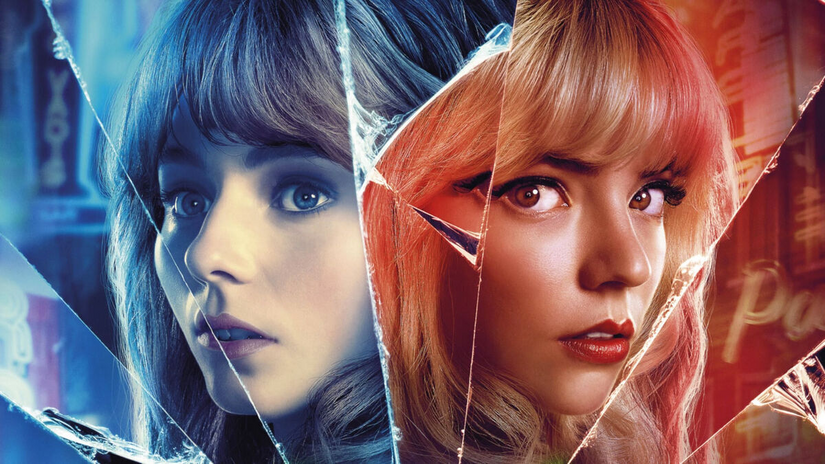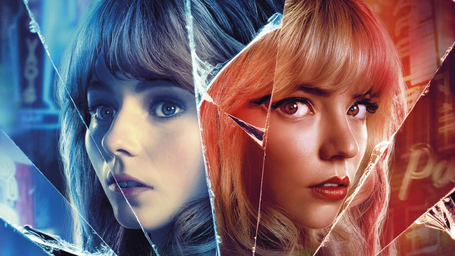After waiting impatiently for Edgar Wright’s newest film that was delayed for over a year due to the pandemic, I finally sat down to watch Last Night in Soho. The film tells the story of aspiring fashion designer, Eloise (Thomasin Mackenzie), who finds herself swept into the dazzling world of London in the ‘60s, where she encounters the glamorous Sandie (Anya Taylor-Joy). However, Eloise soon discovers the grimy underworld beneath the cracked façade and becomes increasingly obsessed by the tragic fate of Sandie, and the horrors of the past.
Going into the film, I expected greatness – an Edgar Wright film staring two of the greatest actresses of their generation? And after seeing the sumptuous costume and set design and beautiful cinematography during the trailers, I didn’t think it could go wrong. And I was right. The visuals were stunning, with the use of mirrors and reflections to show the way in which Sandie and Eloise’s lives and identities become intertwined. The costumes were gorgeous, especially Sandie’s peach chiffon tent dress and white vinyl trench coat, which Eloise later replicates, in her intoxication with the past. Mackenzie and Taylor-Joy’s performances were brilliant, as always.
*Warning – upcoming spoilers and discussion of sex work, sexual abuse, and rape*
eXPECTATIONS, SUBVERTED
Yet, there was so much that I didn’t expect. I thought Last Night in Soho was going to be a feminist cautionary tale about how difficult it was for women artists to get anywhere in London in the ‘60s, and how easy it was for them to run into exploitative violence from men. This is a major thread of the film, as Eloise witnesses in her visions of the past how Sandie fell from aspiring singer in love with the mysterious Jack to being forced into prostitution by him when he is later revealed to be a pimp. Sandie’s increasing disillusionment is tragically depicted in visuals: a montage that shows the same situation occurring over and over again, male ‘clients’ asking the same questions, with the same response (‘That’s a lovely name’) before they undress themselves, with the only changes being in Sandie’s outfits, the faces of the men, and Sandie’s exhaustion.
Some have argued that the film demonizes sex work, by showing that sex work only leads to suffering and death, and by depicting the men who pay for sex as terrible people. To this, I would reply, yes, sex work is appropriately demonized in the film, because Sandie is forced into it against her will, and the men who are paying for her to have sex with them are complicit in her exploitation by the patriarchy. Sandie doesn’t have agency in sex work, because it isn’t her choice – she believes that, somehow, it might bring her closer to her dream of being a singer, like Cilla Black. That isn’t my main issue with the film. My problem with the film relates to the relationship between Eloise and John, a fellow fashion design student (Michael Ajao).
A problematic present-day romance
Initially, John appears to be the perfect foil for the cruelty of other characters in the film. He is caring, sympathetic, and shows kindness to Eloise when no one else does. In other words, John is set up as the perfect friend and potential love interest for Eloise. This romantic subplot is where things get murky in Edgar Wright’s otherwise effective film. To escape from the hauntings of the past and the horrors of her mind, Eloise goes to a Halloween party with John, but it is implied that she is spiked by spiteful student Jocasta. Eloise starts hallucinating and sees the ghosts of the men in Sandie’s life. She is obviously terrified, and when she is escorted outside by John, she kisses him; another form of escapism. Even though it is apparent that Eloise is not in the right state of mind to offer consent, John suggests that they go home together, and Eloise agrees.
What follows is a scene depicting the pair on Eloise’s bed, about to have sex, when she starts seeing a vision of Sandie’s brutal murder and starts screaming – Miss Collins, the older woman she lives with, hears and threatens to call the police. Many critics have noted that this is problematic because John is a Black man framed in an unfortunate situation – an unfounded accusation of rape, which for men like him, could lead to a life in jail – and point to the pitfalls of color-blind casting. The most fanciful event in the film for them is that, a year later, John forgives Eloise for this situation, and becomes her boyfriend.
Yet, Miss Collins doesn’t know that John is Black before threatening to call the police, and even though he is meant to be the contrast for all the disgusting men in Sandie’s life, John clearly sees that Eloise is terrified at the party, that something is wrong, but still asks her to have sex with him. He doesn’t assault or rape Eloise or pressure her into sex, but he takes advantage of her when she is in a vulnerable position – terrified and hallucinating, after a suspected spiking. It doesn’t matter if Eloise seems enthusiastic about it – an inebriated person cannot issue proper consent. And still, John is framed as the only ‘good guy’ in the film, dependable and respectable, and ends up in a relationship with Eloise.
CONCLUSION
With its often brutally frank depiction of sexual exploitation and the problematic relationships between men and women, Last Night in Soho wanders into exceptionally murky territory. While right in its condemnation of the men who exploit Sandy for sex, the film tiptoes around questions of proper consent and healthy sexual relationships in its present-day sequences, with the characterization of John. Perhaps not its intended message, but the message I ultimately took away from the film was the following: no matter how kindly or respectful they appear, all men, when given the chance, will take advantage of women for sex.


